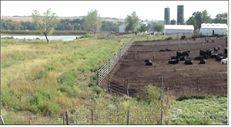Does Siting Matter Relative to Cattle Feeding and Water Quality?
The site selection and management of cattle feeding facilities has a substantial impact on water quality in Kansas. Site location within the prevailing topography and management of cattle feeding pens is imperative to maintaining quality in the waters of the state. There are several factors which should receive consideration when selecting a site that cattle feeding pens will be constructed, as well as factors that demand attention when managing an existing facility.
What did we do?
Cattlemen planning to build a new cattle feeding facility, or perhaps expand an existing facility consider several aspects in relation to water quality. The number of the cattle that will be in the facility, and the size of those cattle are the first considerations. Feeding facilities that feed 300 animal units or more are required to register with KS Department of Health and Environment.. The amount of time cattle are in the pen is a major consideration. Many facilities will have cattle in the pens year-round, but some will only feed cattle for six months or less.
Other considerations when determining a cattle feeding facility include the slope of pen area, which is preferably 1 to 3 percent. The slope of the pen to soils designated as “flooded” is best if relatively flat, no more than 2 percent preferred. The greater the distance to the “flooded” soil, the better. The amount of rainfall and the rainfall intensity for the specific area of the state is noted, and all extraneous drainage should be diverted upslope of the pen area.
 A buffer down-slope of the pen area is essential to managing water quality. The buffer area should be on permeable soils and covered with dense grass. The buffer size should be more than equal to the footprint of the pen, and it is preferred that it be twice the area of the pen. Size of the buffer is influenced by the soils, The more permeable the soil, the greater the infiltration rate, reducing the need for increased size of the buffer area.
A buffer down-slope of the pen area is essential to managing water quality. The buffer area should be on permeable soils and covered with dense grass. The buffer size should be more than equal to the footprint of the pen, and it is preferred that it be twice the area of the pen. Size of the buffer is influenced by the soils, The more permeable the soil, the greater the infiltration rate, reducing the need for increased size of the buffer area.
Groundwater is carefully protected in Kansas, and livestock feeding facilities must be located in areas that are not deemed “ground water sensitive.” Depth to groundwater of all facilities is recorded as well as distance to any existing wells.
Management
The management of the feeding pen system is imperative to maintaining quality water. Pens need to be cleaned regularly to reduce solids leaving the pen and to ensure buffer vegetation is vigorous and free of weeds. The buffer should be hayed to remove nutrients from the system. The pens should be designed and maintained so that runoff leaving pens should flow evenly into and across the buffer to avoid channeling.
The management of livestock waste in cattle feeding facilities deserves the same attention to detail as ration formulation and health protocols.
What have we learned?
The Kansas Center for Agricultural Resources and the Environment, a department of Kansas State Research and Extension, employees a team of five Watershed Specialists who assist cattle producers who routinely keep cattle confined. These specialists work closely with the producer, K-State and the Kansas Department of Health and Environment to make sure cattle facilities are designed in a water quality responsible manner. In addition, these specialists provide educational outreach, design and promote “off stream” water development, encourage restricting cattle from ponds, and advise on proper grazing management of forage resources.
In the past 4 years, these specialists have consulted with 805 livestock producers, affecting over 34,000 animal units. From their efforts, Kansas waterways have seen a reduction in each year of 211,000 pounds of nitrogen, 88,000 pounds of phosphorus and 346 tons of sediment.
Future Plans
Continue educating cattle producers about the importance of properly sited and managed livestock feeding facilities, and helping them achieve water quality responsible goals.
Authors
Jeff Davidson, KSU Watershed Specialist jdavidso@ksu.edu
Ron Graber, KSU Watershed Specialist
Additional information
Jeff Davidson, jdavidso@ksu.edu
Ron Graber, rgraber@ksu.edu
Acknowledgements
EPA 319 funds are a major contributor to this program
The authors are solely responsible for the content of these proceedings. The technical information does not necessarily reflect the official position of the sponsoring agencies or institutions represented by planning committee members, and inclusion and distribution herein does not constitute an endorsement of views expressed by the same. Printed materials included herein are not refereed publications. Citations should appear as follows. EXAMPLE: Authors. 2015. Title of presentation. Waste to Worth: Spreading Science and Solutions. Seattle, WA. March 31-April 3, 2015. URL of this page. Accessed on: today’s date.



